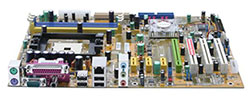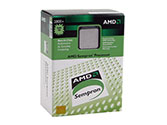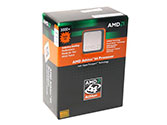Entry Level Buyer’s Guide, July 2005
by Jarred Walton on July 20, 2005 12:05 AM EST- Posted in
- Guides
AMD Recommendations
We have our base recommendation as well as an upgraded recommendation for the AMD side of the equation. The two systems are similar in many areas, but the choice of motherboard, CPU, and graphics card sets them apart.  |
 |
| Click images to enlarge. | |
Budget Socket 754 Motherboard: Foxconn nForce4 NF4K8AB-RS
Price: $78 shipped
Budget Socket 754 CPU: AMD Sempron 2800+ 1.6 GHz 256KB L2 (Retail)
Price: $83 shipped (Retail)
Total: $161
While our basic CPU recommendation remains the same as our last Budget Guide, you'll notice that we've switched motherboards. The main advantage of the Foxconn board is that we get a PCI Express slot, making it a more future-proof solution. Foxconn boards in the past have generally been conservative in approach, but early reports are that this particular board includes overclocking features that should allow you to reach at least a 250 MHz CPU bus if you're interested. (Our own tests with a similar Foxconn board for 939 maxed out at 235 MHz, though, so take those claims with a grain of salt.) The 8X multiplier of the 2800+ is the true limiting factor, giving you a range of 1.8 to 2.4 GHz for a 225 to 300 MHz bus - we figure that the Foxconn board will limit you to 2.0 GHz at best, though we have few doubts that the 90nm Sempron chips can easily run at that speed and more.
If you want better overclocking support, the EPoX EP-8NPAJ or ASUS K8N4-E Deluxe is probably a better choice. Our top pick for socket 754 overclocking continues to be the DFI LANPARTY UT nF3 250Gb, but you'd have to return to an AGP graphics card with the DFI board and we're hesitant to recommend that. The EPoX board only costs another $11, so it's a worthwhile upgrade for the enthusiasts, but the ASUS and DFI boards are quite a bit more expensive. If you're looking at spending that much money on a motherboard, you should probably upgrade to socket 939.
Those interested in cutting costs more can knock off another $11 by dropping to the Sempron 2600+. That has half the cache of the 2800+, but runs at the same clock speed. That should cut performance by about 5 to 7% for a 13% price reduction, but when you look at the total cost of the system, you're really only reducing the price by 2%. Going the other way and upgrading to a Sempron 3000+ or 3100+ is also an option, though the price of the 3100+ is near enough to the Athlon 64 3000+ we list below that we would recommend switching to that platform rather than purchasing a faster Sempron chip.
 |
 |
| Click images to enlarge. | |
Upgraded Socket 939 Motherboard: MSI nForce4 K8N Neo4-F
Price: $85 shipped
Upgraded Socket 939 CPU: AMD Athlon 64 3000+ 1.8 GHz 512KB L2 (Retail Venice core)
Price: $146 shipped (Retail)
Total: $231
For our upgraded AMD setup, we've selected the MSI K8N Neo4-F motherboard with an Athlon 64 3000+. We chose the retail version of the 3000+, though if you're willing to find a suitable HSF, you can get the OEM model for $119 right now. We prefer to avoid the hassle of finding a separate HSF and get the longer warranty, as the total difference in cost after shipping is only about $10. If you want a good overclocking setup, we can vouch for the capabilities of the Neo4-F and the CPU, and when paired with a quality HSF, it's not unusual to hit 2.6 GHz with the Venice cores. We've run some overclocked tests with this CPU and motherboard at 2.2 and 2.4 GHz over a two-week period and didn't experience any difficulties, but your mileage may vary with overclocking.
An alternative to either of these configurations that we've mentioned in the past is the MSI RS480M2-IL 939 board. That includes integrated graphics that are roughly equal to the Radeon X300SE HyperMemory in performance - in other words, the best of the IGP world, but still lacking in 3D performance. While the cost of the board is about the same as that of the Neo4-F, you no longer have to purchase a graphics card. That makes it a wash with the budget setup, but you get a faster CPU. Overclocking is not available on the RS480M2, however, so avoid it if you're interested in tweaking your system for higher performance levels.










57 Comments
View All Comments
OldPueblo - Thursday, July 21, 2005 - link
Doh. Anyway, the Asus website has the specs listed and they do say 700Mhz. Is the website wrong then? http://usa.asus.com/prog/spec.asp?m=Extreme%20N620...Graphics Engine NVIDIA GeForce 6200 w/TurboCache
Video Memory 64MB/64bit DDR onboard
Effective Memory Size 256MB
Effective Memory Bandwidth 128bit
Engine Clock 350MHz
Memory Clock 700MHz(350MHz DDR)
RAMDAC 400MHz
Bus Standard PCI Express 16X
Max Resolution 2048x1536
VGA Output Standard 15-pin D-sub
Vedio Output Composite
DVI Output DVI-D (Available only in TD model)
2nd VGA Output N/A
Adaptor/Cable bundled N/A
OldPueblo - Thursday, July 21, 2005 - link
Calin - Thursday, July 21, 2005 - link
JarredWalton, I would buy a 17" LCD - however, I think the resolution is just too small. So I will have to wait for a 19" LCD that has the same resolution, but the text has a readable size, in order not to experience all those artifacts generated by non-native resolution.Zebo - Thursday, July 21, 2005 - link
I still say a sub $75 TC videocards like you recommned is worthless for gaming, even at low res 1024x768 featured on 15" LCDs it studders.. Need 600/700pro or 6200/6600 minimum. Again what's wrong with $50 mobos with inegrated graphics for a budget setup? Millions of Americans who shop at Dell get integrated graphics every year and could care less. But I do bet they opt for 17" or even 19" LCD's with thier package.BPB - Thursday, July 21, 2005 - link
Geez, how'd I miss that? I was specifically looking for the RS480M2-IL too. Sorry.BPB - Thursday, July 21, 2005 - link
Geez, how'd I miss that? I was specifically looking for that too.kmmatney - Thursday, July 21, 2005 - link
They really need some Semprons for S939 - the MSI RS480M2-IL is not very compelling for a budget system without Semprons.JarredWalton - Wednesday, July 20, 2005 - link
14/38: the MSI board is mentioned as an integrated graphics alternative. No OC'ing features at all, so not everyone will like it, but I did mention that the cost of a discrete graphics card basically makes the MSI+939 the same price as the budget mobo+CPU+GPU and you get a faster CPU. (See page 2, last paragraph.)BPB - Wednesday, July 20, 2005 - link
#14, I agree with you. Got the MSI RS480M2-IL and built a very nice system for my daughter. With the saving on video card got a better CPU. When she needs it I'll get her a better video card. I started out with the same hard drive as the article and then added another, bigger drive. For a monitor she has the Samsung 17" 730B purchased at Staples, on sale for about $200. Very happy with everything. Also, the MSI board supports the X2 CPUs so it has great upgrading potential should I decide to use it for my video editing system and build something else for her.JarredWalton - Wednesday, July 20, 2005 - link
Due to an error in specifications, we have changed the budget GPU recommendation to an X300SE - the cheapest PCIe card with DVI that we could find. It turns out that the ASUS does *not* have 700MHz RAM - in fact, we couldn't find any 64-bit 6200TC cards with 700MHz RAM. The price of the better TurboCache models is getting dangerously close to that of faster models, so we decided to simply cut the price $20 and go with a cheaper card. The graphics page and summaries have been updated accordingly. If you can find a card that offers substantially better performance in the $50 to $65 range, send me an email.(Grumble: The overlapping specs on the low-end graphics cards is a nightmare of confusion. /Grumble)